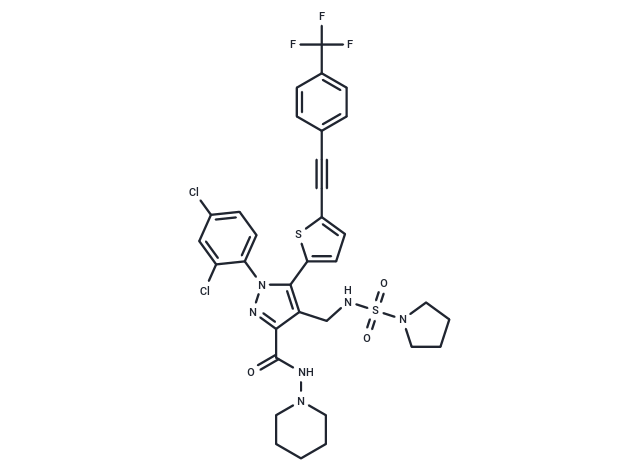Shopping Cart
- Remove All
 Your shopping cart is currently empty
Your shopping cart is currently empty

CB1-IN-1 (DBPR211) is a peripherally restricted CB1R antagonist, for CB1R and CB2R with Ki of 0.3 nM and 21 nM,respectively.

| Pack Size | Price | Availability | Quantity |
|---|---|---|---|
| 1 mg | $79 | In Stock | |
| 2 mg | $118 | In Stock | |
| 5 mg | $199 | In Stock | |
| 10 mg | $286 | In Stock | |
| 25 mg | $469 | In Stock | |
| 50 mg | $654 | In Stock | |
| 100 mg | $882 | In Stock | |
| 500 mg | $1,770 | In Stock | |
| 1 mL x 10 mM (in DMSO) | $238 | In Stock |
| Description | CB1-IN-1 (DBPR211) is a peripherally restricted CB1R antagonist, for CB1R and CB2R with Ki of 0.3 nM and 21 nM,respectively. |
| Targets&IC50 | CB2 receptor:21 nM, CB1 receptor:0.3 nM |
| Alias | DBPR211 |
| Molecular Weight | 751.67 |
| Formula | C33H31Cl2F3N6O3S2 |
| Cas No. | 1429239-98-4 |
| Smiles | FC(F)(F)c1ccc(cc1)C#Cc1ccc(s1)-c1c(CNS(=O)(=O)N2CCCC2)c(nn1-c1ccc(Cl)cc1Cl)C(=O)NN1CCCCC1 |
| Relative Density. | 1.49 g/cm3 (Predicted) |
| Storage | Powder: -20°C for 3 years | In solvent: -80°C for 1 year | Shipping with blue ice. | ||||||||||||||||||||
| Solubility Information | DMSO: 11 mg/mL (14.63 mM), Sonication is recommended. | ||||||||||||||||||||
Solution Preparation Table | |||||||||||||||||||||
DMSO
| |||||||||||||||||||||

Copyright © 2015-2025 TargetMol Chemicals Inc. All Rights Reserved.